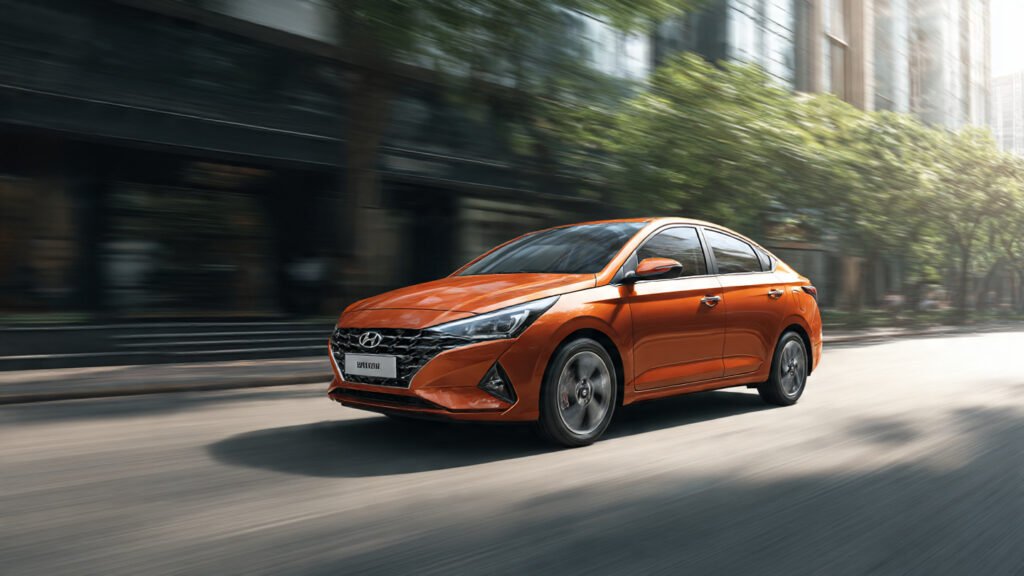If you’re exploring the mid-size sedan segment in India, the 2026 Hyundai Verna stands out as a compelling option—with sharp styling, strong powertrain credentials, and premium features. In this article, we take a deep dive into the Verna’s design, features, performance, practicality, and how it fits Indian roads (especially given the somewhat modest ground clearance for rough surfaces).

Design & Styling –
Hyundai has injected the Verna with a bold and contemporary design language.
The front fascia features signature LED lighting and a sleek grille treatment, giving it a sporty stance.
The side profile emphasises a fastback-inspired sweep, while the rear is clean and modern.
On the interior, expect premium touches: a large infotainment screen, digital-instrument cluster in higher trims, and upscale upholstery.
Spy shots show the 2026 model will get a facelift rather than a complete redesign—most changes are cosmetic around the front and rear.
The official Hyundai India site also hints at enhanced features under the highlight section.
Hyundai
In short: The Verna offers a strong “premium sedan” visual appeal—suitable if you want a more upscale look compared to ordinary compact sedans.
Engine, Transmission & Performance –
Under the hood, the Verna continues with a capable engine lineup:
A 1.5-litre naturally aspirated petrol engine (~115 PS) for everyday driving.
A 1.5-litre turbo-petrol variant (~160 PS / 253 Nm) for those wanting stronger performance.
Transmission options include 6-speed manual, CVT (for the NA engine), and a 7-speed DCT (for the turbo version) as per expectations.
Driving impression:
The NA engine offers smooth, relaxed commuting performance; the turbo variant adds a noticeable punch—ideal if you drive highway or want sporty feel.
Fuel economy:
While official 2026 numbers aren’t fully published, the previous spec shows ~18-20 kmpl in ARAI-rated figures.
Features & Technology –
The Verna brings a well-loaded set of features, especially in upper trims:
Touchscreen infotainment with Android Auto / Apple CarPlay.
Ventilated front seats, wireless charger, digital key (facelift expectations) for the 2026 model.
Safety suite: multiple airbags, stability control, tyre-pressure monitoring and more.
The 2026 update is expected to add more advanced driver-assistance systems (ADAS) and improved cabin tech.
Bottom line: The Verna punches above its class in features, making it a strong value proposition if you pick the right variant.
Practicality & Comfort –
For daily usage and Indian road conditions:
Seating for 5 occupants, with decent leg-room and boot space (~528 litres as per prior data).
Drive comfort is prioritised—well-tuned suspension for city + highway driving.
Ground clearance: While exact figure for the 2026 model is still awaited, earlier versions and estimates for the Verna class suggest something around 165-170 mm, which is decent for city/highway, though not as generous as some SUVs.
If you often use extremely bad rural roads, stepped speed-breakers or large potholes, you might find some under-body scraping risk compared to higher-clearance vehicles.
Ground Clearance & Indian Road Scenarios –
Given your (and many Indian buyers’) concern about ground clearance, here’s a closer look:
- Sedans like the Verna are naturally lower than SUVs; the estimated ~165-170 mm clearance (not officially confirmed yet) is adequate for city and well-paved highways.
- However, on rougher surfaces, steep drop-offs or large raised speed-breakers, caution is advised—especially when fully loaded.
- If your driving profile includes rough village roads or off-pavement tracks, you may want to evaluate whether a higher-riding vehicle better fits your needs.
- That said: For the majority of urban + highway commutes, the Verna’s ride height and chassis are a fine balance between comfort and stability.
Pricing & Competitive Positioning –
Estimates suggest the 2026 Verna could start around ₹12 lakh (ex-showroom, India) for base variants.
In its segment, the Verna competes with models such as the Honda City, Skoda Slavia, and other premium sedans.
Its strengths lie in styling, tech-rich feature list, and the turbo-petrol performance version.
Pros & Cons –
✅ Pros –
Strong engine options including turbo variant
Premium styling and rich features
Up-to-date cabin tech and comfort amenities
⚠️ Cons –
Ground clearance not excessive—some caution required on very poor roads
Sedans are losing market share to SUVs—resale/perception may slightly differ
The facelift is mostly cosmetic: buyers looking for radical change may need to wait further.
8. Verdict –
If you’re looking for a stylish, well-equipped sedan in India that delivers both comfort and performance, the 2026 Hyundai Verna is a very strong choice. It balances premium feel with practicality, and its turbo-petrol version opens up a fun-to-drive dimension.
That said, if your primary usage involves very poor roads or rough terrain frequently, you might want to check clearance carefully at your local dealership and drive it yourself to ensure there are no under-body concerns.
